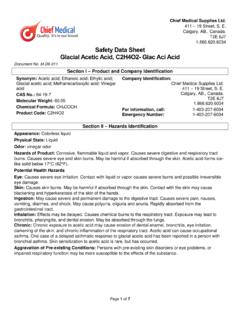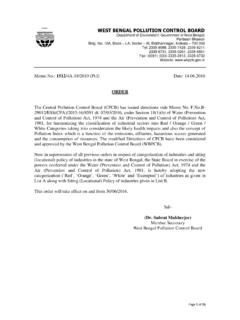Transcription of Safety Data Sheet Citric Acid 20% - Chief Medical …
1 Chief Medical Supplies Ltd. 411 19 Street, S. E. Calgary, AB., Canada. T2E 6J7. Safety data Sheet Citric acid 20%. Document No. M-D6-019. section I Product and Company Identification Synonym: 2-Hydroxy-1,2,3-Propanetricarboxylic Company Identification: acid Chief Medical Supplies Ltd. CAS No.: 77-92-9 411 19 Street, S. E. Calgary, AB., Canada. Molecular Weight: T2E 6J7. Chemical Formula: C6H8O7 Product Code: CA20-4 For information, call: 1-403-207-6034. Emergency Number: 1-403-207-6034. section II Hazards Identification Appearance: Clear colorless liquid Physical State: Liquid Odor: Odorless Hazards of Product: Causes eye and skin irritation.
2 May cause respiratory tract irritation. Potential Health Hazards Eye: Causes severe eye irritation. Skin: Causes skin irritation. May cause skin sensitization, an allergic reaction, which becomes evident upon re-exposure to this material. Some references state that Citric acid has allergenic properties but, no animal or human studies were found to support this claim. It does not seem likely that Citric acid is a sensitizer since it is found in the body as an essential component of the Citric acid cycle which releases energy for physiological functions.
3 Citric acid is widely distributed in plants and in animal tissues and fluids. Ingestion: May cause gastrointestinal irritation with nausea, vomiting and diarrhea. Excessive intake of Citric acid may cause erosion of the teeth. Inhalation: May cause respiratory tract irritation. Because its vapor pressure is negligible, it exists in the air only as a mist or spray. section III Composition/Information on Ingredients Ingredient Name Chemical Formula CAS No. % by weight Critic acid C6H8O7 64-19-7 20%. Water H2O 7732-18-5 80%. Page 1 of 5.
4 section IV First Aid Measures Skin Contact: In case of contact, flush skin with plenty of water. Remove contaminated clothing and shoes. Get Medical aid if irritation develops and persists. Wash clothing before reuse. Eye Contact: In case of contact, immediately flush eyes with plenty of water for at least 15 minutes. Get Medical aid. Inhalation: If inhaled, remove to fresh air. If not breathing, give artificial respiration. If breathing is difficult, give oxygen. Get Medical aid. Ingestion: If swallowed, do not induce vomiting unless directed to do so by Medical personnel.
5 Never give anything by mouth to an unconscious person. Get Medical aid. section V Fire Fighting Measures Conditions of flammability: Not available Flash point and method of determination: Not available Upper flammable limit: Not available Lower flammable limit: Not available Auto-ignition temperature: Not available Hazardous combustion products: Not applicable Explosion data - sensitivity to mechanical impact: Not available Explosion data - sensitivity to static discharge: Not available Fire Fighting Media and Instructions: Use DRY chemicals, CO2, alcohol foam or water spray.
6 Special Remarks on Fire Hazards: Not available Special Remarks on Explosion Hazards: Not available section VI Accidental Release Measures Spill: Absorb spill with inert material ( vermiculite, sand or earth), then place in suitable container. Avoid runoff into storm sewers and ditches which lead to waterways. Clean up spills immediately, observing precautions in the Protective Equipment section . Provide ventilation. Spill may be carefully neutralized with lime (calcium oxide, CaO). section VII Handling and Storage Handling Procedures: Wash thoroughly after handling.
7 Remove contaminated clothing and wash before reuse. Use with adequate ventilation. Avoid contact with eyes, skin, and clothing. Keep container tightly closed. Avoid ingestion and inhalation. Avoid breathing spray or mist. Storage Requirements: Store in a tightly closed container. Store in a cool, dry, well-ventilated area away from incompatible substances. Page 2 of 5. section VIII Exposure Controls/Personal Protection Engineering Controls: Facilities storing or utilizing this material should be equipped with an eyewash facility and a Safety shower.
8 Use adequate ventilation to keep airborne concentrations low. Personal Protection Eyeware: Chemical splash goggles Gloves: Gloves Clothing: Synthetic apron Respirator: Follow the OSHA respirator regulations found in 29 CFR or European Standard EN. 149. Use a NIOSH/MSHA or European Standard EN 149 approved respirator if exposure limits are exceeded or if irritation or other symptoms are experienced. Exposure Limits: OSHA Permissible Exposure Limit (PEL): 25 ppm (TWA); ACGIH Threshold Limit Value (TLV): 10 ppm (TWA); 10 ppm (STEL). section IX Physical and Chemical Properties Physical state: Liquid Odour and appearance: Odorless Odour threshold: Not available Specific gravity: Not available Vapour pressure: Not available Vapour density: Not available Evaporation rate: Not available Boiling point: Not available Freezing point: Not available pH (1% soln/water): Not available Coefficient of water/oil distribution: Not Available Taste: Not available Critical Temperature: Not available Dispersion Properties: Not available Solubility.
9 Soluble in water section X Stability and Reactivity Stability: Stable Conditions to avoid: Incompatible materials, excess heat. Incompatible materials: Oxidizing agents, potassium tartrate, alkalis, alkali carbonates, acetates, sulfides (inorganic, ferric sulfide, lead sulfide, sodium sulfide), bicarbonates, metal nitrates, strong oxidizing agents, metals, strong reducing agents, strong bases. Conditions of reactivity: Not available Hazardous decomposition products: Carbon monoxide. Carbon dioxide. Special Remarks on Corrosivity: Not available Polymerization: Will not occur Page 3 of 5.
10 section XI Toxicological Information Route of entry: Not available Effects of Acute exposure: Not available Other Toxic Effects on Humans: Not available Irritancy of product: Not available Sensitization to product: Not available Carcinogenicity: Not available Reproductive toxicity: Not available Teratogenicity: Not available Mutagenicity: Not available Toxicologically synergistic products: Not available Toxicity to Animals: Not available Special Remarks on other Toxic Effects on Humans: Not available section XII Ecological Information Ecotoxicity: Not available BOD5 and COD: Not available Products of Biodegradation: Possibly hazardous short term degradation products are not likely.








